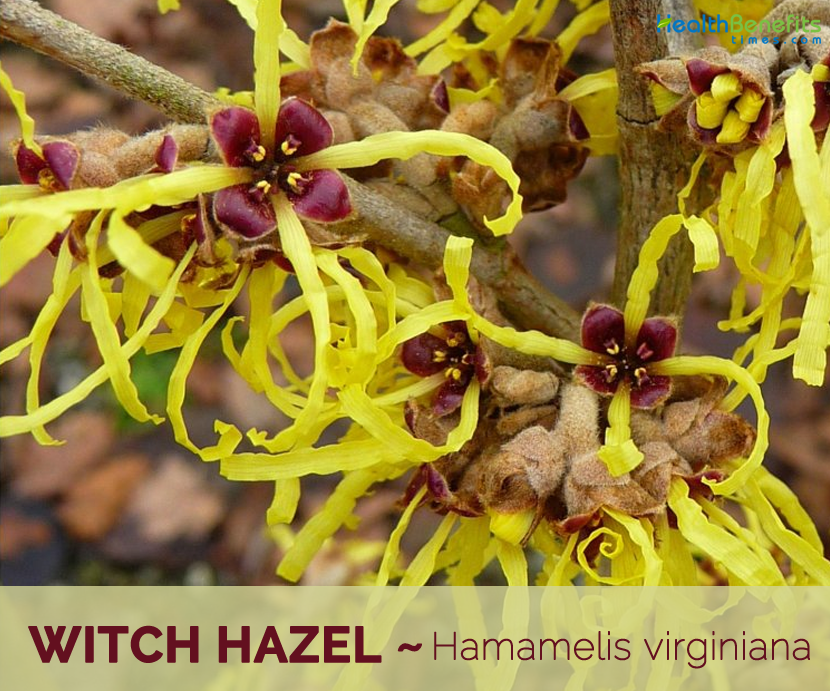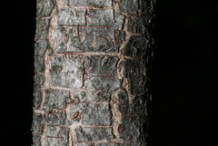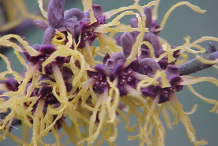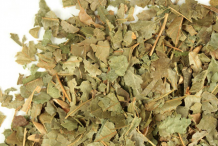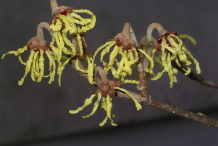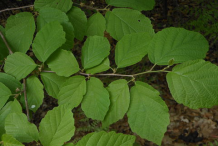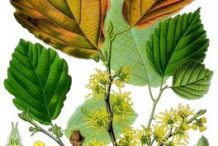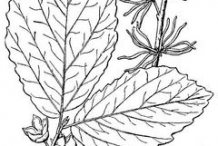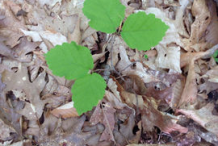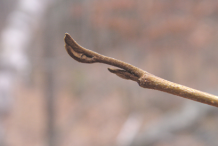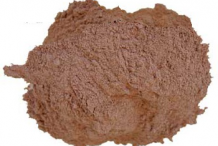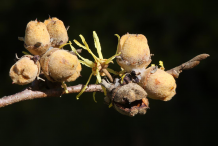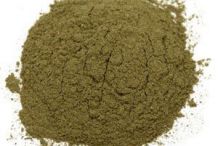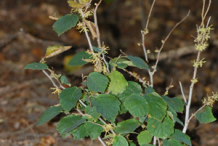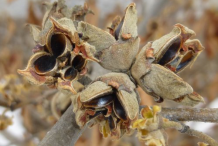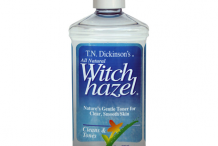Plant Description
Witch Hazel is a small, flowering deciduous shrubs and small tree that grows about 12 to 30 feet in height and 15 to 20 feet in width. The plant is found growing in mesic typical woodlands and sandy woodlands, savannas and sandy savannas, woodland borders, foredunes near Lake Michigan, and restored woodlands. Witch-Hazel is occasionally cultivated as an ornamental shrub/tree in yards or along buildings. The plant prefers average, medium moisture, well-drained soils. It also prefers moist, acidic, organically rich soils and tolerates heavy clay soils. The herb has smooth, thin bark that is brown on the surface and reddish-purple from the inside. Branchlets are pubescent at first, later smooth, light orange brown, marked with occasional white dots, finally dark or reddish brown. Twigs are flexible and rough, color externally, yellowish-brown to purple, wood greeny white, pith is small.
Leaves
Leaves are oval, 3.7–16.7 cm long and 2.5–13 cm broad, oblique at the base, acute or rounded at the apex, with a wavy-toothed or shallowly lobed margin, and a short, stout petiole 6–15 mm long. The midrib is more or less hairy, stout, with six to seven pairs of primary veins. The young leaves open involute, covered with stellate rusty down; when full grown, they are dark green above, and paler beneath. In fall, they turn yellow with rusty spots. The leaf stipules are lanceolate, acute; they fall soon after the leaf expands.
Flower & Fruit
Flowers are pale to bright yellow, rarely orange or reddish, with four ribbon-shaped petals 10–20 mm long and four short stamens, and grow in clusters; flowering begins in about mid-fall and continues until late fall. The flower calyx is deeply four-parted, very downy, orange brown within; imbricate in bud, persistent, adhering with the base of the ovary. Two or three bractlets appear at base. Flowering normally takes place from September to November. Fertilized flowers will form fruit over a long period extending through winter and into the following growing season. Fruits are greenish seed capsules 10–14 mm long, that become woody with age and mature to light brown. Each seed capsule splits open in fall of the following year, exploding the 1-2 black seeds within for up to 30 feet. Seeds are small; black that is white and oily on the inside. Bark, stems and leaves are used to make a decoction and applied to various parts of the body for relief. Due to its proven effectiveness, witch hazel has become a part of many different commercial cosmetic and medical products.
Mature capsule bursts and scatters seed 10 to 20 feet (rarely 40 feet) away from the mother plant. That’s how witch hazel got a nickname “snapping hazel”. Fruit of witch hazel is important source of food for the pheasants, grouses, bob-whites, white-tailed deer, beavers and black bears. Native Americans used seed of witch hazel in various sacred rituals. Bark and leaves of witch hazel are used to accelerate healing of the wounds and to stop the bleeding. Witch hazel is also used in treatment of diarrhea and inflammation of eyes.
Health Benefits of Witch Hazel
Witch hazel (Hamamelis virginiana) was long known by the American Indians to have amazing properties for healing swellings and bruises. Now it is used in deodorants, pile cures, to clear spotty skin, remove bags under the eyes and much more. It is classified by the US Food and Drug Administration as a class 1 drug, which means it can make efficacy claims. Listed below are few of the popular health benefits of witch hazel
1. Soothe Aches and Pains
Witch hazel is well known as a topical medicine for its effects on inflammation associated with arthritis, as well as sore muscles and joints caused by physical exercise, injury, or advanced age. Combining with equal parts water or virgin olive oil, simply apply it to the affected area and allow the tannins and antioxidants do their work. (1)
2. Speed Healing
When it comes to cuts, bruises, abrasions and other wounds, many people have turned to witch hazel for thousands of years. Organic compounds within witch hazel make it a powerful astringent substance, meaning that it can help to tighten skin. This makes the healing process much faster and can slow down bleeding of an open wound. However, with badly ruptured skin, it is not recommended that you apply it, as the potency of the components could cause more inflammation in the wound.(2)
3. Eliminate Headaches
Astringent properties of witch hazel can be seen in full effect when used to soothe headaches. You can topically apply its extract on the temples, which help to ease the tension of the small capillaries that often cause headaches. Furthermore, you can brew a cup of witch hazel tea to drink, which should ease blood pressure and relax the throbbing muscles or blood vessels that are causing your discomfort.(3)
4. Immune System
Research has shown that witch hazel is able to stimulate the immune system and actively eliminate pathogens and foreign agents in the body, due to its antibacterial and antiseptic qualities. This is evident in the herbal decoction’s effect on the skin, but when drunk in tea form, it can also be a natural booster to your overall health.(4)
5. Skin Health
Since many years, witch hazel is used as an herbal decoction. It is known to clear up acne, psoriasis, boils, and pimples, as well as cracked skin, inflammation and rashes. If you have been bitten by an insect, or are experiencing hives, you can also topically apply witch hazel to the skin. Again, you can mix this with an equal amount of water, or some other type of carrier oil. This will protect the wound or irritated area from infection, and also promote healing.(5)
6. Heal Respiratory Tracts
Several research has proven witch hazel to have a positive effect on the respiratory tracts in the case of sore throats, inflammation of the vocal chords, irritation from coughing, and other issues dealing with the throat. Witch hazel, when brewed in the form of a tea, rather than using the extract or concentrated oil, can be gargled for rapid relief. This helps to eliminate soreness and pain, while also drying up excess mucus, which is where infections often develop.(6)
7. Ease Digestion
Since ancient times Witch hazel has been used as a stomach tonic and only a small amount of witch hazel tea is required. It is particularly effective when combined with chamomile or mint. This mixture has been known to clear up the symptoms of IBS, diarrhea and dysentery, by encouraging the immune system and reducing inflammation caused by potential bacteria in the gut.(7)
8. Hemorrhoids
Due to the astringent and anti-inflammatory properties, Witch hazel is used for the treatment of hemorrhoids. It can be applied to the inflamed tissues that make up hemorrhoid and provide relief. Be careful in terms of application, however, due to the strength of the decoction. Also, if you are already on blood-clotting medicine, be sure to speak with your doctor before using it.(8)
9. Menstruation Relief
Witch hazel can be quite beneficial for women who suffer particularly heavy periods, due to its astringent properties. It helps to slow the bleeding that occurs during menstruation and decrease pain and inflammation in the groin. This can also help with other symptoms of menstruation, such as bloating and cramps. Depending on your particular medical condition, it may be best to speak with your gynecologist before adding it to your health schedule. (9)
10. Fade Bruises and Blemishes
Witch hazel can be used to treat blemishes already present on the face or other areas of the body. Apply witch hazel with a cotton ball or cosmetic pad to lessen irritation and appearance of acne or other inflammatory skin conditions. Witch hazel applied to bruises can also help to fade discoloration and speed up the healing process of any underlying damage.
11. Soothes a Sore Throat
Witch hazel has a soothing effect on a sore throat. Boil some bark and leaves in water and let it steep for several minutes to prepare a concentrated herbal drink, which is commonly known as the witch hazel tea. A cup of strong and lukewarm witch hazel tea will eliminate the prickly sensation in your throat and alleviate the swelling of the larynx. Be sure to use fresh witch hazel and not the one which you get at the drugstore that contains alcohol. It is unhealthy for internal use. Also, drink this preparation lukewarm and not when hot.
12. Prevent and reduce the appearance of stretch marks
Stretch marks are a typical problem for pregnant women, but they can also affect anyone who gains weight rapidly for whatever reason. For this reason, teenagers occasionally get stretch marks as well during periods of faster growth or changes during puberty.
Stretch marks are pretty tough to get rid of, but one method many people report great success with is witch hazel! Witch hazel helps to tighten loose skin around the scars, which in turn can decrease their appearance. You can use it as a preventative too, so this is something every pregnant woman should have on hand!
13. Treat Damaged Gums
Witch hazel mouth rinse can help to reduce pain and swelling of irritated or infected gums. Witch hazel can be used to stop minor bleeding of the gums and mouth. Try a teaspoon of witch hazel tea with one drop each clove and myrrh oil to safely relieve teething pain for infants. The same treatment may also be used to calm pain caused by emerging wisdom teeth or after oral surgery to reduce discomfort and inflammation.
14. Soothe Diaper Rash
Anti-inflammatory properties of witch hazel make it an effective and safe remedy for soothing pain from diaper rash. Frequent application will assist in healing damaged skin faster, further reducing your baby’s discomfort.
15. Drying “swimmer’s ear”
‘Swimmer Ear’ or Otitus Externa is normally caused by microbial infections of the ear canal. Use the eye dropper to insert several drops of witch hazel into each ear dries out pus, clean the excessive oil, and broke the wax and debris that may block the ear canal.
16. Post treatments for Hair-Removal
Witch Hazel not only stop the bleeding but anti-inflammatory witch hazel also works to prevent razor burn. Additionally, for those who are in hot wax treatment for hair-removal or waxing can use witch hazel as post-waxing anti-inflammatory or use it to stop the bleeding from damaged hair follicles.
17. Treat chicken pox blisters
Combination of aloe, honey, lavender and other essential oils create a spray that massively reduces the discomfort of chicken pox blisters. And it’s all-natural. Here’s what to do:
Mix together 1 tablespoon honey, 40 drops lavender essential oil, 15 drops lemon essential oil, 15 drops bergamot essential oil, 5 drops peppermint essential oil, 1 teaspoon carrot seed oil and 1/2 cup aloe vera gel.
Once completely mixed, and 1/2 cup distilled witch hazel and mix again. Pour mixture into spray bottle and use on affected areas. It is a more potent and less unsightly way to treat the chicken pox than traditional calamine lotion.
18. Beneficial for Acne
Witch Hazel works like an anti-inflammatory agent and helps reduce swelling in the tissues of the skin. Dip a cotton ball in some witch hazel oil and dab it on your acne. Witch hazel oil will cut back the excessive secretion of sebum, which is a major cause of acne. You will notice an amazing difference in the way you look after using witch hazel oil for a few days. Your skin would appear clearer and firmer.
19. Treats Dandruff
If you are suffering from dandruff, you may like to treat your itchy scalp with witch hazel oil. Comb your hair to ease out the frizzes. Divide your hair into several sections and massage the oil directly onto the scalp. Leave it for some time before you shampoo your hair. It is quite useful method of treating dandruff.
20. Remove a tick
Ticks can’t stand witch hazel. If you find a tick rooted into your dog or cat’s body, put a few drops of witch hazel on top of it. It should loosen up its grip. At that point, you can grab it and pull it off successfully. You can then disinfect the site using the same witch hazel. Note that this doesn’t just work on your pet. It also can work on you or your kids if one of you picks up a tick. It’s very important to get rid of ticks as quickly as possible, and witch hazel can help speed up the job.
Other Benefits of Witch Hazel
Apart from its health promoting benefits it is quite beneficial for other household purposes. Listed below are few of the popular household uses of Witch Hazel.
1. Postpartum Care
Witch hazel extract is useful for soothing post-birth. You do this by pouring more natural witch hazel organic cotton (and even add spices or aloe vera to soothe extra).
2. For Stretch Marks
Witch Hazel can fade stretch marks to almost completely disappear by spraying with witch hazel extract once a day for several months.
3. Clean your jewelry
Cleaning jewelry poses a challenge, because you need something effective enough to lift debris, grease, and oxidization, but whatever you use needs to be gentle enough not to damage metals and gemstones. For this reason, you have to avoid harsh detergents (even some commercial jewelry cleaning solutions are too strong to use safely!).
Witch hazel makes for a great alternative for a lot of jewelry cleaning jobs. It’s really easy. You just dab some on a cotton ball and carefully wipe down your jewelry. You can also use the witch hazel as a soak if you prefer. Around 20 minutes should do it.
4. Use as a paint thinner
If you add some witch hazel to paint, you can thin it out. Rubbing alcohol works for this too. Both of them speed up drying time as well, so you get the job done faster. You’ll save a lot of money this way, as actual paint thinner can be quite expensive.
5. Use it to clean your bathroom
Witch hazel turns out to be a phenomenal cleaner for your bathroom. Don’t use it on its own. Instead, create a mixture by combining it with baking soda and lemon juice. This will make it tougher on soap scum, mildew, and stains.
6. Make your own floor cleaner
Have tile, vinyl or linoleum floors to keep clean in your bathroom or kitchen? Instead of spending a lot of money on expensive floor cleaning solutions, just pour half a cup of witch hazel into a gallon of warm water. Stir the mixture together and start mopping. Witch hazel solvents are great for stripping off old wax, and the warm water meanwhile takes care of the dirt and debris. If you need to, you can also try adding a tablespoon of borax
7. Create your own air freshener
Mix a cup of water, half a cup of witch hazel, and around 15 drops of your favorite essential oils into a spray bottle. Use this mixture as an air freshener anywhere in your house. It’s a lot more eco-friendly than a commercial air freshener, and the smell will be much better too. You can customize it to your heart’s content, and the scents are actually natural.
8. Make your own glass cleaner
Same mixture of witch hazel, lemon juice, and baking soda that works so well as a bathroom cleaner can also be mixed together in a spray bottle and used on your glass windows, mirrors, and chrome surfaces. After you wipe it down, you can just leave it to dry off. Since it is alcohol-based, it will evaporate quickly all on its own (this is also why it helps paint to dry).
9. Use it to clean your eyeglasses
Instead of purchasing eyeglasses cleaning solution from the store, why not make it yourself quickly and economically at home? All you need to do is mix one part water with one part witch hazel (you can also use isopropyl alcohol), and one drop of soap. Be sure to use a gentle soap that won’t be too severe on your glasses.
https://www.youtube.com/watch?v=D3yYghnPQ3w
Traditional uses and benefits of Witch hazel
- Boiling the stems of the shrub produce a decoction, this was used to treat swellings, inflammations, and tumors.
- Bark and leaves were used by Native Americans in the treatment of external inflammations.
- Witch hazel bark is a traditional herb of the North American Indians who used it to heal wounds, treat tumors, eye problems etc.
- It is commonly used in the West and is widely available from both herbalists and chemists.
- It is an important ingredient of branded eye drops, skin creams, ointments and skin tonics.
- It is widely used as an external application to bruises, sore muscles, varicose veins, hemorrhoids, sore nipples, inflammations etc.
- Bark is astringent, haemostatic, sedative and tonic.
- Tannins in the bark are supposed to be responsible for its astringent and haemostatic properties.
- Bark is used internally in the treatment of diarrhea, colitis, dysentery, hemorrhoids, vaginal discharge, excessive menstruation, internal bleeding and prolapsed organs.
- An infusion of the leaves is used to reduce inflammations, treat piles, internal hemorrhages and eye inflammations.
- Homeopathic remedy is made from fresh bark.
- It is used in the treatment of nosebleeds, piles and varicose veins.
- It is used cosmetically as an ingredient in almost any preparation made to relieve capillary weaknesses.
- Stems have been used for water divining.
- Trees are too small to be a useful lumber source.
- Decoction has been utilized for incipient phthisis, gleet, ophthalmia, menorrhagia and the debilitated state resulting from abortion.
- Tea made of the leaves or bark may be taken freely with advantage, being good for bleeding of the stomach and in complaints of the bowels.
- An injection of this tea is excellent for inwardly bleeding piles, the relief being marvelous and the cure speedy.
- In cases of bites of insects and mosquitoes a pad of cotton-wool, moistened with the extract and applied to the spot will soon cause the pain and swelling to subside.
- Diluted with warm water, the extract is used for inflammation of the eyelids.
- It is widely used for skin treatment and helps to removes excess oil from the skin.
- It helps to clear the face, it reduces the amount of blemishes, bruises and black heads from the skin.
- It reduces inflammation and puffiness around the eyes.
- It is natural remedy for treating discoloration around the eyes.
- It reduces swelling and pain in varicose veins.
- It decreases the blood pressure in swollen veins.
- It eases pain, itching, swelling and bleeding of Hemorrhoids.
- Herbal teas help to eases discomfort of sore throat.
- Gargle with witch hazel tea reduces swelling, dry up excess mucus and throat problems.
- It is used as a treatment for swimmer’s ear.
- It is used in combination with Manjakani to tighten loose vagina and brace up sagging breast.
Ayurvedic Health benefits of Witch Hazel
- Urticaria: Prepare a decoction of the leaves of Witch Hazel. Wash the affected area with this two times a day.
- Piles: Prepare a decoction of Witch Hazel. Have a glass once a day.
- Puffy Eyes: Prepare a decoction of Witch Hazel leaves. Dip a piece of cotton cloth in to it. Put it over the eyes for 10-15 minutes.
- Cuts and Burns: Apply Witch Hazel oil to the affected area. OR Extract the oil of Witch Hazel’s from leaves and bark. Apply it over the cut part or the burn part.
- Sore Throat: Make a tea of Witch Hazel leaves. Have one cup once a day.
- Eczema: Make a paste of Witch Hazel leaves. Apply directly to the affected area.
- Insect bites: Witch Hazel reduces inflammation. Apply Witch Hazel oil to the affected area. OR Apply the paste of Witch Hazel leaves directly over the insect bites.
- Dandruff: Apply Witch Hazel oil to the scalp.
- Bloody Stool: Prepare a decoction of Witch Hazel leaves. Have a glass once a day.
- Hematoma: Extract the oil from Witch Hazel leaves and bark. Massage the affected area with this oil two three times a day.
- Warts: Drops 3 to 4 drops of Witch Hazel on a cotton ball. Apply it on the warts. Leave it for half an hour. Repeat this 2 to 3 times a day. Continue till you get rid of the wart.
- Metrorrhagia: Infuse 1 tsp of dried Witch Hazel leaves in one cup of hot water for 15-20 minutes. Drink it twice a daily.
- Rectal Prolapse: Soak a cotton ball in Witch Hazel oil and apply it over the affected area. Repeat the process 3 to 4 times a day.
- Piles: It combines with Amaranth for the treatments of piles. It can be used as an ointments for local applications. It can be taken internally as an infusion. Prepare an infusion of he dried leaves. Let leaves steep for 10-15 minutes. Take thrice a day.
- Acne: Mix 4 tsp of tea tree essential oil with 4 tsp of witch hazel oil. Apply it on the affected area.
- Blurred Vision: Take leaves and flower of eyebright, goldenseal, Oregon grape, chamomile, Marigold, witch Hazel. Prepare an infusion. Use this infusion to dampen a soft cloth. Keep it over your eyelids and lie down for 10 minutes.
- Itching: Take equal quantity of Golden seal and Witch Hazel. Grind them together. Add little water to make a paste. Apply on the affected parts for 20 minutes and then wash.
- Wrinkles: Take 1\4th cup each of Witch Hazel and comfrey. Put 2 tbsp of Patchouli essential oil. Apply on the affected area with cotton balls.
- Varicose veins: Take powder form of 5 tbsp of Witch Hazel nuts and one tbsp of Horse chestnut. Mix it well. Apply it over the affected area.
- Anal Fissures: Take 2 tbsp of powdered chamomile, 2 tbsp of powdered Witch Hazel. Put them in half liter of water until it remains half. Cool and strain. Wash the affected area with this thrice a day.
- Dark Circles: Take equal amount of Witch Hazel oil, almond oil, Eucalyptus oil, Rose oil, Chamomile oil. Mix them together. Apply it under eyes twice a day.
- Brittle Nails: Take 2 tbsp each of Aloe vera gel and Witch Hazel oil or gel. Mix them well and apply over your fingernails.
- Piles: Take quarter cup of witch hazel and add 20 drops each of Frankincense, Helichrysum and lavender essential oil in it. Mix them well. Dab a cotton ball with this oil blend and apply over the affected area.
- Oily Skin: Take quarter cup of Witch Hazel and add eight drops of fennel essential oil in it. Mix them well. Dab a cotton ball with this blend and apply to the face. Repeat the process two times a day.
Make your own deodorant
Witch hazel is often used in deodorants due to its natural skin-healing and skin-care properties. Here is a home-made recipe you may want to try.
Ingredients
- 1 tsp high proof vodka
- 10 drops geranium
- 10 drops cypress
- 8 drops bergamot
- 5 drops neroli
- 4 drops lavender
- 3 drops black pepper
- 4 tbsp (40 ml) witch hazel
- 2 tbsp (25 ml) cornflower water
- 2 tbsp (25 ml) orange flower water
Directions
- Measure the vodka into a 4 oz. (100 ml) glass bottle with a spray attachment.
- Carefully add the essential oils, one by one.
- Shake vigorously to dissolve the essential oils.
- Pour the witch hazel into the bottle, using a funnel if necessary, followed by the two flower waters. Shake well.
- Label the bottle and the deodorant is now ready to use.
- Before you use the deodorant each time, give the bottle a good shake to ensure the essential oils are fully dispersed.
Precautions
- Avoid long-term use due to cancer risk (from high tannin content).
- Avoid during pregnancy and breastfeeding.
- 1g ingested can cause vomiting, nausea, impaction.
- Topical use may cause dermatitis.
- Excess oral consumption can result in dizziness, rash or nausea.
- Very rarely, people experience dark urine, yellowed skin and eyes, and severe stomach pain.
- Pregnant or nursing mothers should avoid using it until they have consulted a doctor.
References:
https://www.itis.gov/servlet/SingleRpt/SingleRpt?search_topic=TSN&search_value=19033#null
https://davesgarden.com/guides/pf/go/806/
https://npgsweb.ars-grin.gov/gringlobal/taxonomydetail.aspx?id=311636
http://www.pfaf.org/user/Plant.aspx?LatinName=Hamamelis+virginiana
http://www.missouribotanicalgarden.org/PlantFinder/PlantFinderDetails.aspx?kempercode=a749
https://www.botanical.com/botanical/mgmh/w/withaz27.html
http://www.theplantlist.org/tpl1.1/record/tro-15100007
https://plants.usda.gov/core/profile?symbol=havi4
https://en.wikipedia.org/wiki/Witch-hazel
Comments
| Witch Hazel Quick Facts | |
|---|---|
| Name: | Witch Hazel |
| Scientific Name: | Hamamelis virginiana |
| Origin | Eastern North America |
| Colors | Green when young turning to light brown |
| Shapes | Fuzzy, brown hard woody capsule 10–14 mm long, |
| Taste | Astringent and bitterish aromatic |
| Health benefits | Hemorrhoids and Heal Respiratory Tracts |
| Name | Witch Hazel |
|---|---|
| Scientific Name | Hamamelis virginiana |
| Native | Eastern North America, from Nova Scotia west to Minnesota, and south to central Florida to eastern Texas |
| Common Names | American witch-hazel, Common Witchhazel, Virginian Witchhazel, Witchhazel, Hazel nut, snapping hazel, tobacco wood, hamamelis water, spotted alder, winter bloom, hamamelis water |
| Name in Other Languages | Danish: Virginsk Troldnød English: American Witch-hazel, witch hazel, witchhazel Finnish: Amerikantaikapaehkinae, Amerikantaikapähkinä French: Café du diable, hamamélis de Virginie, hamémelis Latin: Cortex Hamamelidis, Folia Hamamelidis Portuguese: Hamémelis Swedish: Amerikansk trollhassel |
| Plant Growth Habit | Small, flowering deciduous shrubs and small tree |
| Growing Climate | Mesic typical woodlands and sandy woodlands, savannas and sandy savannas, woodland borders, foredunes near Lake Michigan, and restored woodlands |
| Soil | Average, medium moisture, well-drained soils. It also Prefers moist, acidic, organically rich soils and tolerates heavy clay soils. |
| Plant Size | Up to 12 to 30 feet in height and 15 to 20 feet in width |
| Bark | Smooth, thin bark that is brown on the surface and reddish-purple from the inside |
| Branchlets | Pubescent at first, later smooth, light orange brown, marked with occasional white dots, finally dark or reddish brown |
| Twigs | Flexible and rough, color externally, yellowish-brown to purple, wood greeny white, pith small |
| Leaf | Oval, 3.7–16.7 cm long and 2.5–13 cm broad, oblique at the base, acute or rounded at the apex, with a wavy-toothed or shallowly lobed margin, and a short, stout petiole 6–15 mm long |
| Flowering Periods | Sep to November |
| Flower | Pale to bright yellow, rarely orange or reddish, with four ribbon-shaped petals 10–20 mm long and four short stamens |
| Fruit Shape & Size | Fuzzy, brown hard woody capsule 10–14 mm long |
| Fruit Color | Green when young turning to light brown |
| Seed | Small, black seed that are white and oily on the inside. |
| Flavor/Aroma | Inodorous |
| Taste | Astringent and bitterish aromatic taste |
| Plant Parts Used | Twigs, Bark, dried; leaves, fresh and dried |
| Lifespan | Survive around 20 years in the wild. |
| Health Benefits |
|
| Season | Aug to September |
| Culinary Uses |
|
| Lifespan |
|


